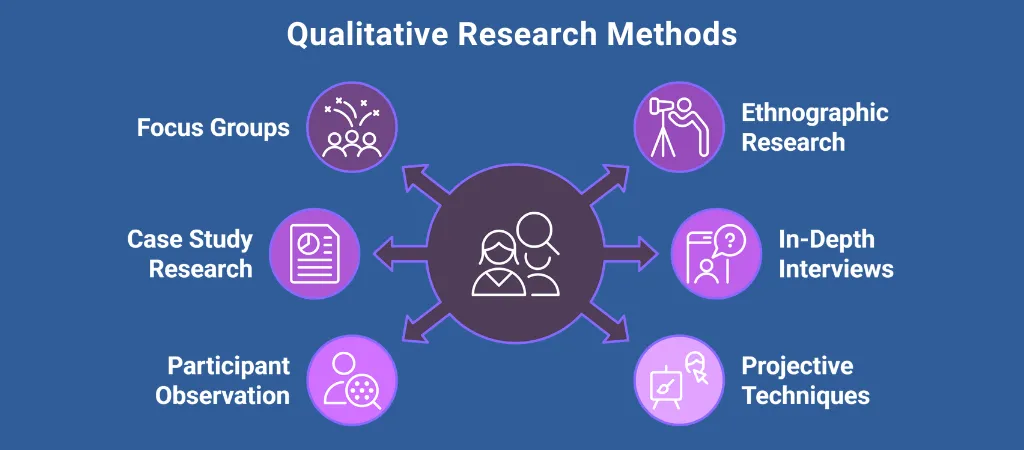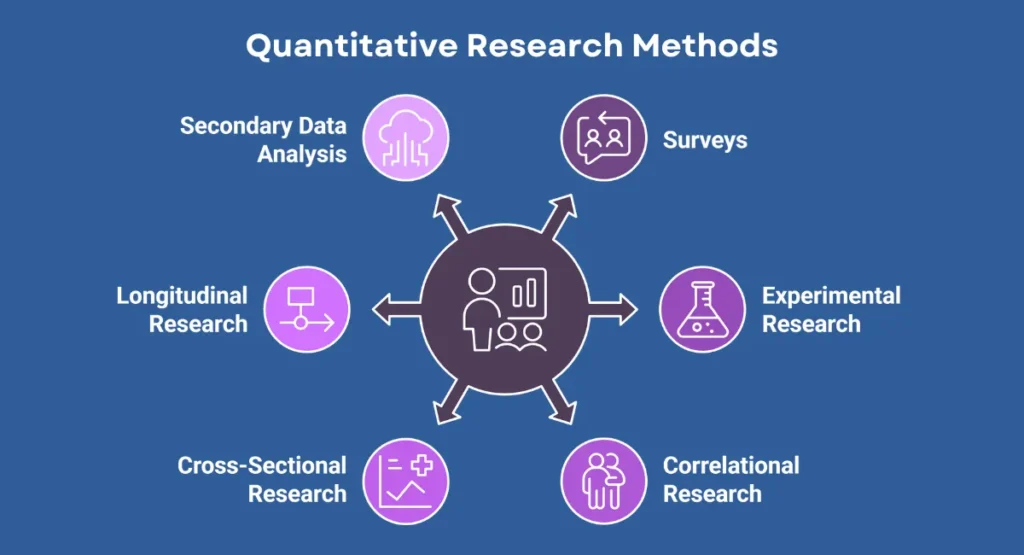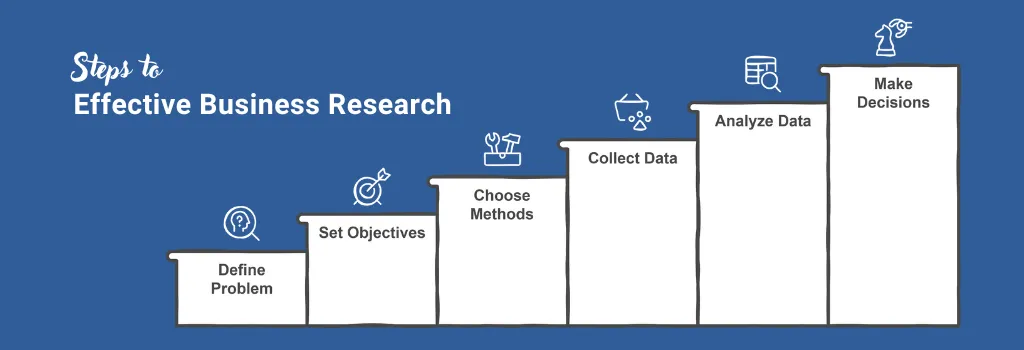Business research methods are the secret weapon behind successful companies. Whether it’s launching a new product, improving customer service, or entering a new market, businesses rely on research to make informed decisions, giving you the confidence to steer your company in the right direction.
The global market research industry reached a record high of approximately 54 billion U.S. dollars in 2023, proving that companies worldwide continue to invest heavily in data-driven strategies.
In this guide, we’ll break down everything you need to know about business research methods, including types of research, data collection strategies, and real-world examples.
Let’s dive in!
Table of Contents
ToggleWhat is Business Research?
Business research is like a GPS for companies—it helps them navigate challenges and find opportunities. The purpose of business research is to gather facts, analyze trends, and solve problems.
More importantly, it is the cornerstone of informed decision-making, providing the necessary data and insights to guide strategic choices.
For example, a coffee shop might conduct market research to figure out why customers prefer lattes over cappuccinos or use surveys to improve its menu.
Similarly, a tech company might use case study research to understand why a competitor’s product failed, or a retail chain might use participant observation to improve its customer service.
Whether you’re a small business owner or a corporate leader, conducting business research can help you minimize risks and maximize opportunities.
Key Goals of Business Research
The primary goal of business research is to provide reliable information that helps organizations make informed decisions.
- Understanding customer needs (e.g., analyzing customer feedback and purchasing patterns).
- Identify opportunities for growth (e.g., expanding into new markets or launching new products)
- Reducing risks (e.g., predicting sales before opening a new store).
- Evaluate the effectiveness of marketing strategies (e.g., measuring ROI on digital campaigns and social media ads)
- Improve product or service quality (e.g., conducting quality assurance testing and gathering customer reviews)
- Enhance operational efficiency (e.g., automating repetitive tasks and optimizing supply chain management)
Without research, businesses would make guesses instead of data-driven choices.
Guesswork won’t grow your business—data will. The right research methods help you uncover hidden opportunities, outsmart competitors, and make confident decisions.
Business Research Methods and Types
There are two main types of business research—qualitative and quantitative.
Let’s explore each type with common business research methods used by researchers to understand customer behavior, improve products or services, and make informed decisions.
Primary vs. Secondary Research:
- Primary Research: Collecting new data directly from sources.
- Pros: Specific to needs, up-to-date.
- Cons: Time-consuming, costly.
- Tools: Surveys, interviews.
- Secondary Research: Using existing data.
- Pros: Cost-effective, quick.
- Cons: It may not be specific or current.
- Sources: Academic journals, industry reports.
1. Qualitative Research Methods
Qualitative business research methods focus on why people behave the way they do. It uses open-ended questions, observations, and discussions to dig deeper into opinions and experiences. Common qualitative methods include:

Focus Groups
A focus group is a small discussion group led by a moderator. Businesses use this method to collect customer feedback about a product or service.
How It Works:
- A business invites 6–12 people from its target audience.
- A moderator asks open-ended questions about a product, service, or ad campaign.
- Participants share their opinions and experiences.
- The company analyzes the feedback to improve its product or marketing strategy.
🔹 Example: A cosmetic brand tests a new anti-aging cream with a focus group. Customers say the bottle is too bulky, so the company redesigns the packaging.
Ethnographic Research
This method involves watching people in real-life settings to see how they use a product or service.
How It Works:
- A researcher visits a store, home, or workplace to observe customers.
- They take notes on behaviors, challenges, and preferences.
- The business uses these insights to improve its products or services.
🔹 Example: A supermarket chain studies how shoppers move through aisles. The research shows that customers struggle to find organic products, so the store adds better signs and a separate organic section.
Case Study Research
A case study is a deep investigation of a company, product, or business event.
How It Works:
- A business chooses a company or industry trend to study.
- Researchers collect past data, interview experts, and analyze results.
- The case study helps other businesses learn from past mistakes or successes.
🔹 Example: A tech startup studies why a competitor failed despite having a great product. The research finds that poor customer support leads to bad reviews. The startup improves its customer service to avoid the same mistake.
In-Depth Interviews
This method involves one-on-one interviews to collect detailed feedback from customers.
How It Works:
- A company interviews customers, employees, or industry experts.
- The interviewer asks open-ended questions to understand experiences and opinions.
- The company analyzes responses to improve products or services.
🔹 Example: A luxury hotel chain interviews frequent guests to find out what makes their stay enjoyable. Customers love personalized welcome notes and custom room service, so the hotel is expanding these services.
Participant Observation
In this method, the researcher joins the environment as an employee or customer.
How It Works:
- The researcher works or shops at a business to experience it firsthand.
- They take notes on customer behavior and business operations.
- The company uses these findings to improve customer experience.
🔹 Example: A restaurant chain hires a researcher to work as a waiter for a week. The researcher finds that customers ask for healthier options, so the restaurant adds low-calorie meals to the menu.
Projective Techniques
This method helps businesses understand hidden customer opinions by using creative exercises like storytelling or word association.
How It Works:
- Customers are given fun tasks like filling in blanks, choosing images, or making comparisons.
- The business analyzes the results to understand brand perception.
🔹 Example: A car company asks customers, “If our brand were an animal, what would it be?” Responses like “a lion” (strong, powerful) or “a cheetah” (fast, sleek) help shape the brand’s image.
2. Quantitative Research Methods

Quantitative business research methods use numerical data to answer questions about how many, how much, or how often. It helps in making informed decisions by analyzing statistical data. Common quantitative methods include:
Surveys
Surveys ask customers structured questions to gather measurable data.
How It Works:
- A business creates a multiple-choice or rating-scale questionnaire.
- The survey is sent out online, by phone, or in person.
- The results are analyzed to find patterns and trends.
🔹 Example: A gym chain surveys customers and learns that 70% want longer weekend hours. The gym extends its hours, leading to a 20% increase in visits.
Experimental Research
This method tests cause-and-effect relationships by changing one factor and measuring its impact.
How It Works:
- A business creates two versions of a product, ad, or pricing strategy.
- One group gets the new version, while another gets the old version.
- The company compares results to see which version works better.
🔹 Example: A beverage company tests two different bottle designs. The bottle with brighter colors sells 30% more, so the company switched to that design.
Correlational Research
This method looks at relationships between different factors without changing anything.
How It Works:
- Researchers collect data on two or more variables.
- Statistical analysis shows if the variables are related.
🔹 Example: A fashion brand studies whether more Instagram ads lead to higher sales. They find that increased social media spending leads to a 40% boost in online purchases.
Cross-Sectional Research
This method studies different groups at the same time to compare behaviors.
How It Works:
- Researchers survey different age groups, locations, or customer segments.
- The results show how opinions or behaviors differ.
🔹 Example: A bank surveys millennials and baby boomers about investments. Millennials prefer cryptocurrency, while baby boomers prefer mutual funds.
Longitudinal Research
This method tracks the same group of people over time to see how behaviors change.
How It Works:
- A company surveys the same customers every year.
- The results show how preferences evolve over time.
🔹 Example: A telecom provider tracks customer satisfaction for five years. The research finds that faster network speeds lead to higher customer loyalty.
Secondary Data Analysis
This method uses existing data from industry reports, government records, or past research.
How It Works:
- Researchers collect data from trusted sources.
- The data is analyzed to find trends and patterns.
🔹 Example: A real estate firm studies government housing reports to predict future demand for rental properties.
How to Conduct Business Research: A Simple How-To
If you want to learn more about how to do research, here is an easy guide.

The process generally includes the following steps:
1. Easy Steps to Get Started
- Define Your Problem: Write down what you want to find out.
- Set Objectives: Decide what you want to learn from the research.
- Choose Your Methods: Pick from surveys, interviews, or observations.
- Collect Data: Gather information from your customers and market.
- Analyze Data: Look for clear trends or answers.
- Make Decisions: Use your findings to guide your business steps.
2. Tips for Successful Research
- Keep it Simple: Use clear questions.
- Be Systematic: Follow a plan step by step.
- Use Reliable Sources: Check facts with trusted sources. For example, read articles on Harvard Business Review or look at stats from Statista.
- Stay Flexible: Adjust your plan if needed.
3. Business Research Design
A strong business research design makes your work more reliable. Here are some points to consider:
- Sample Size: How many people will you ask?
- Data Collection Tools: Will you use online surveys or face-to-face interviews?
- Time Frame: When will you collect and analyze your data?
Data Collection: How to Gather Reliable Information
Data collection is the backbone of research. Here’s how businesses do it:
- Surveys: Ask your target audience direct questions. Use tools like Google Forms.
- Interviews: One-on-one chats to explore more profound insights.
- Observations: Watch how customers use your product.
- Existing Data: Use past sales reports or industry studies.
Pro Tip: For balanced insights, mix open-ended questions (“What do you dislike about our app?”) with closed ones (“Rate our app from 1–5”).
Importance of Business Research in Decision-Making
Research-driven decision-making helps businesses avoid costly mistakes and stay ahead of the competition. Key benefits include:
- Enhancing Customer Satisfaction: Understanding customer needs helps in improving products and services.
- Reducing Risks: Making informed decisions minimizes uncertainties.
- Identifying Market Trends: Businesses can adjust their strategies based on consumer behavior.
- Improving Financial Performance: Data-driven decisions lead to better investments and resource allocation.
Want to see how research can give your business an edge? Check out this guide on the benefits of market research for insights and practical tips!
Conclusion
Business research methods help companies stay ahead of trends, solve problems, and connect with their target audience.
By mixing qualitative research methods (like case studies) with quantitative ones (like experiments), businesses make smarter, faster decisions.
Ready to start? Pick one problem to solve, gather data, and let the facts guide you!
Need expert help with market research? 🚀 Vicino’s Market Research Services provide deep insights, competitor analysis, and data-backed strategies to give your business a competitive edge.
👉 Get started today and turn insights into action!





